Abstract
Pedigree analysis of British families with Leber hereditary optic neuropathy (LHON) closely fits a model in which a pathogenic mtDNA mutation interacts with an X-linked visual loss susceptibility locus (VLSL). This model predicts that 60% of affected females will show marked skewing of X inactivation. Linkage analysis in British and Italian families with genetically proven LHON has excluded the presence of such a VLSL over 169 cM of the X chromosome both when all families were analyzed together and when only families with the bp 11778 mutation were studied. Further, there was no excess skewing of X inactivation in affected females. There was no evidence for close linkage to three markers in the pseudoautosomal region of the sex chromosomes. The mechanism of incomplete penetrance and male predominance in LHON remains unclear.
Full text
PDF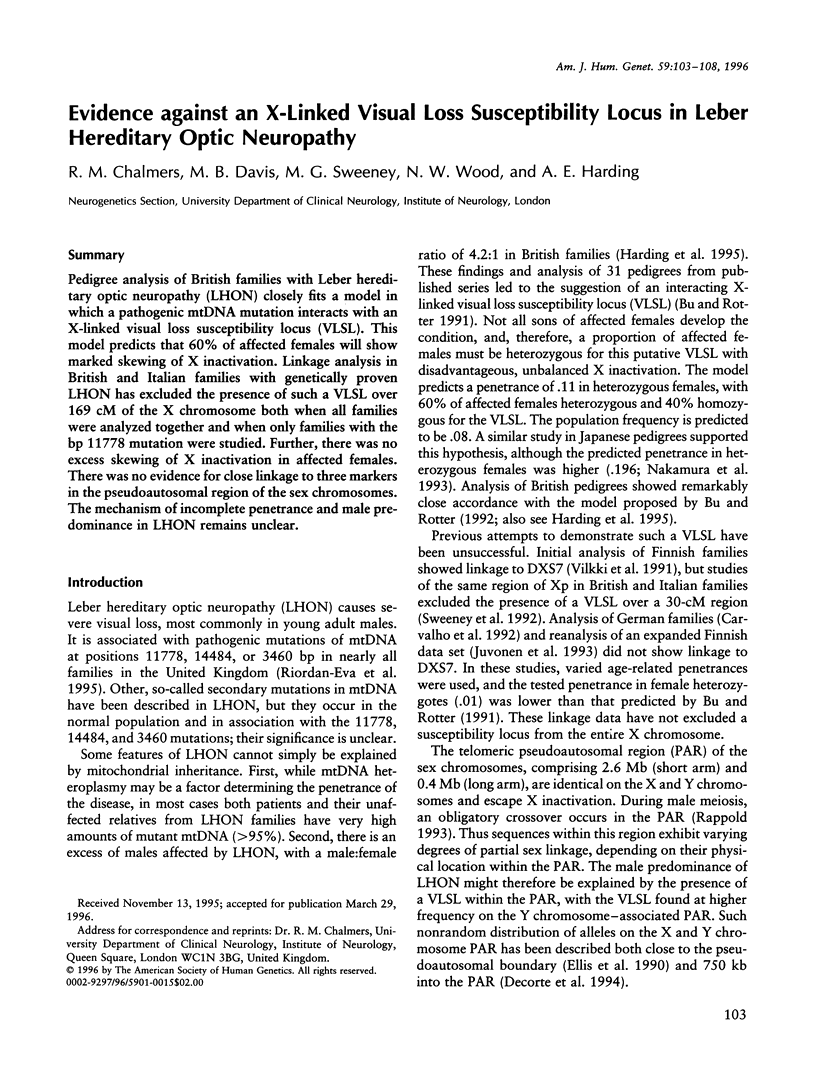
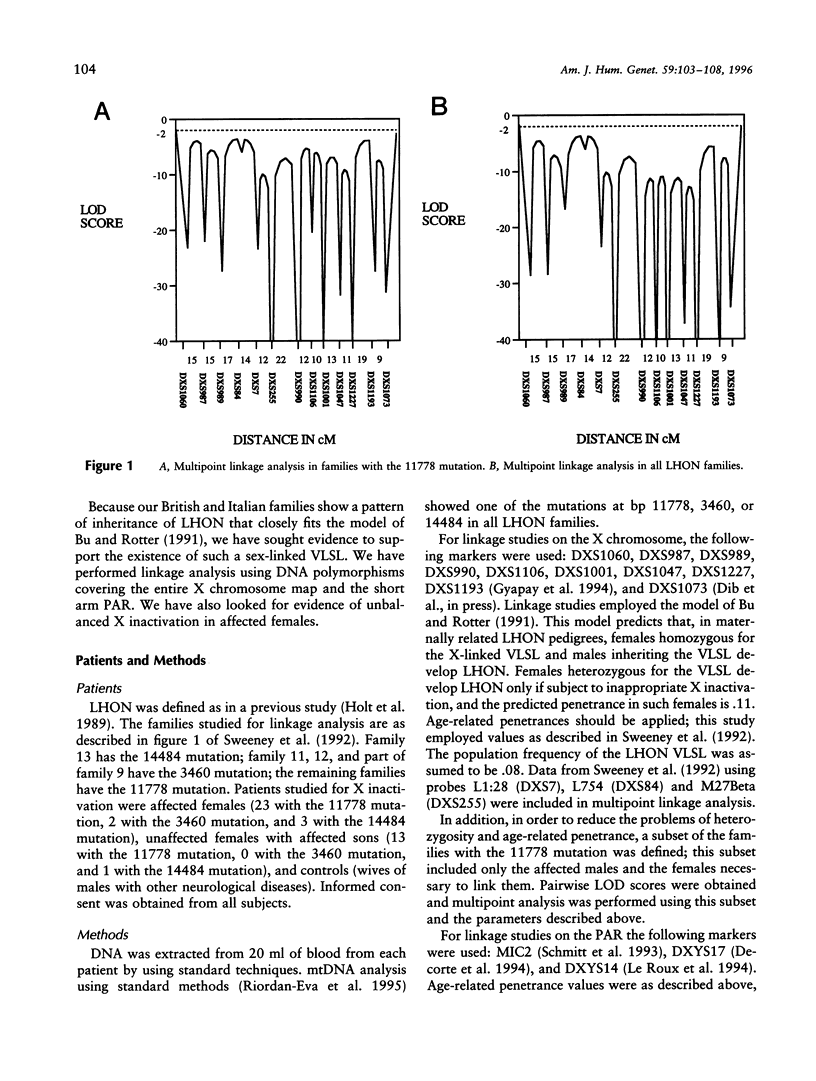
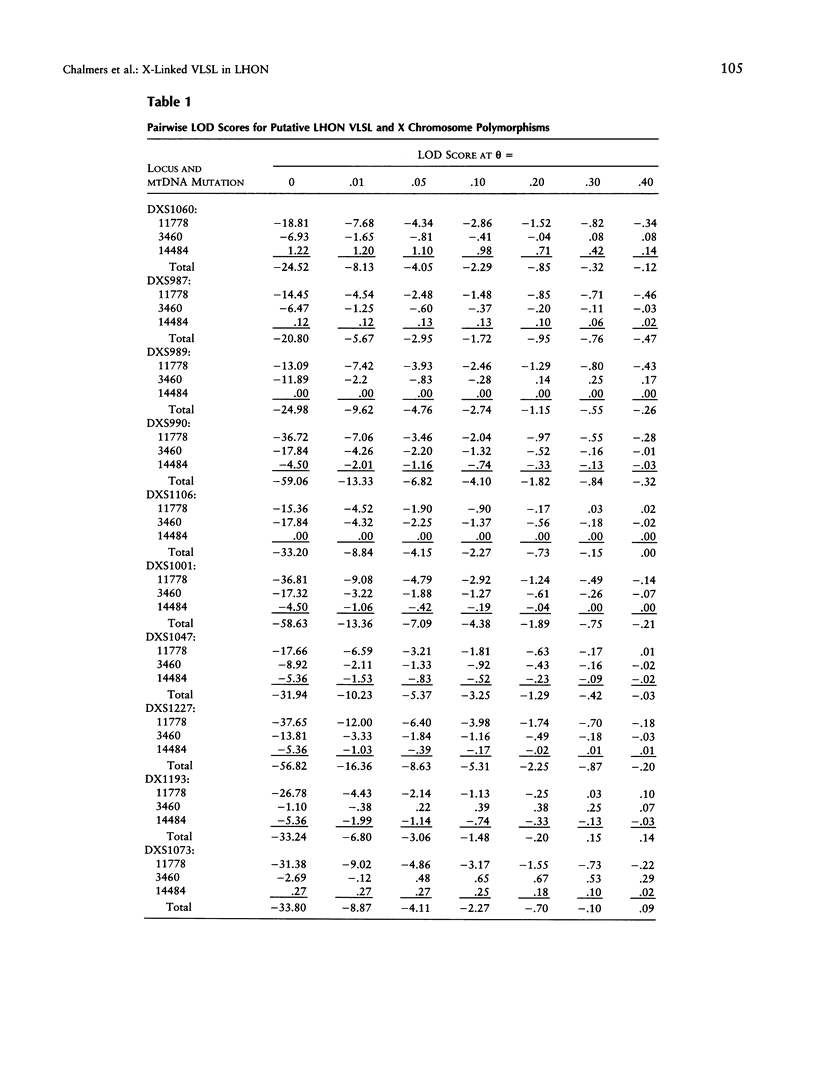
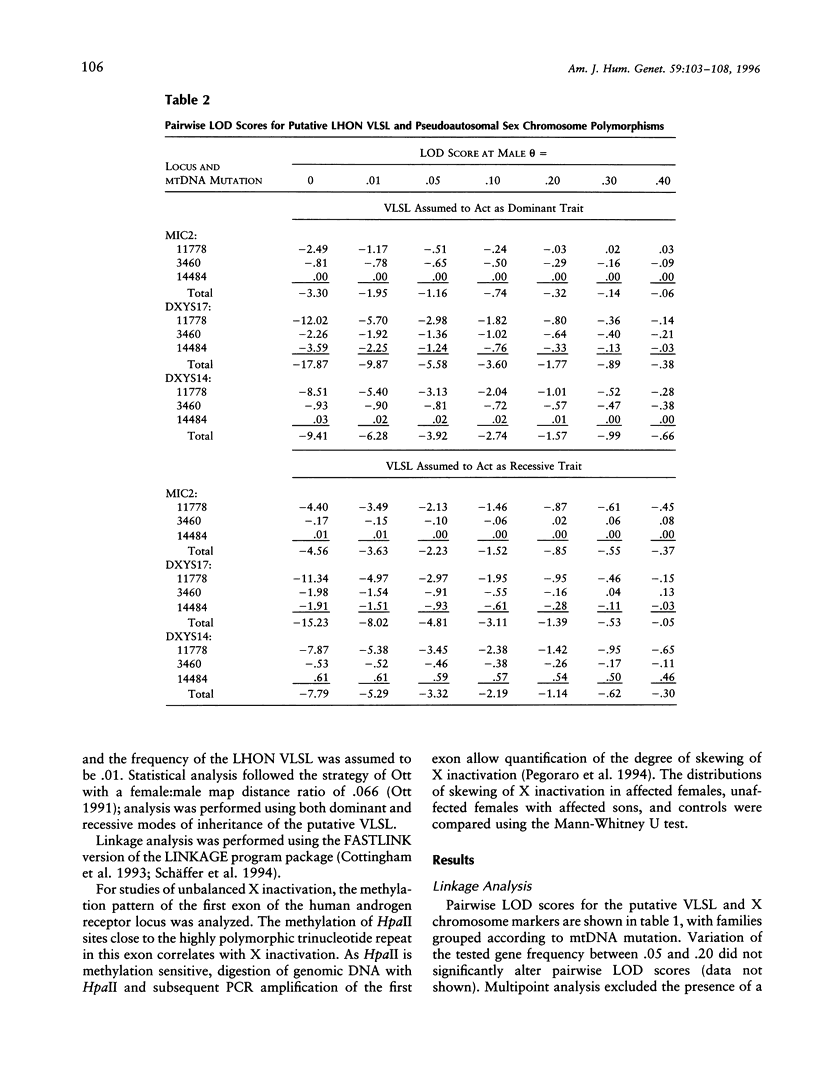
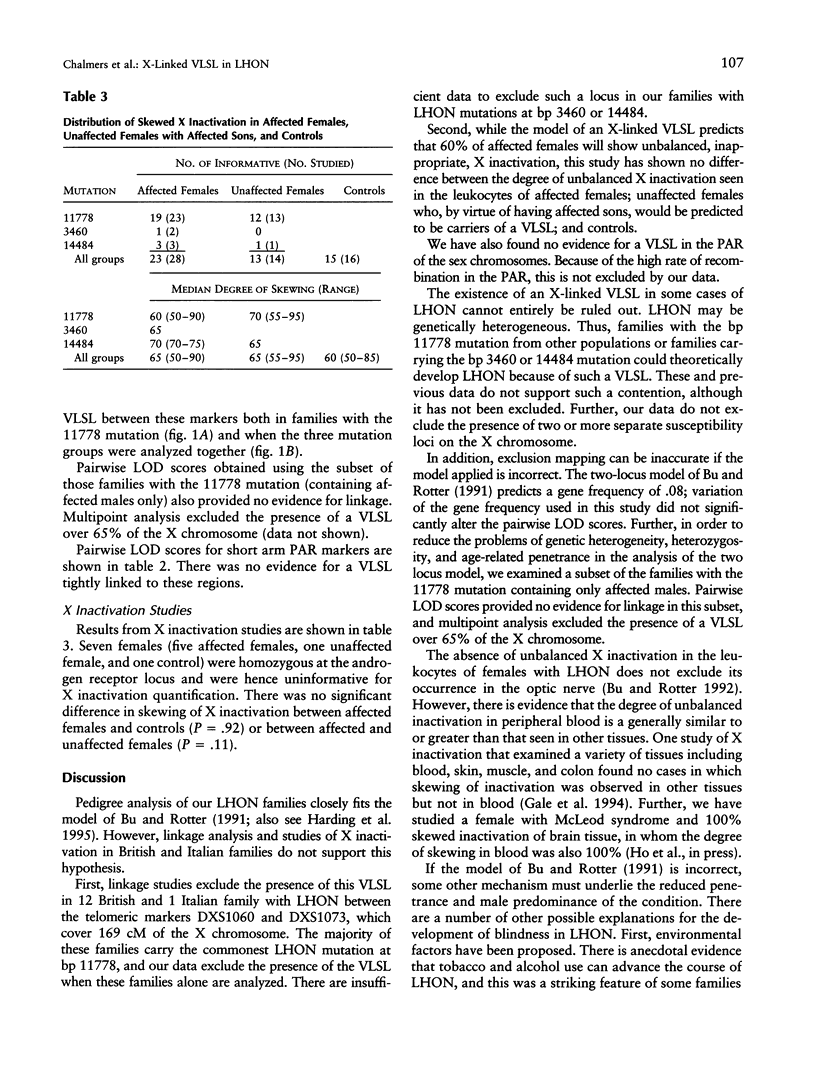
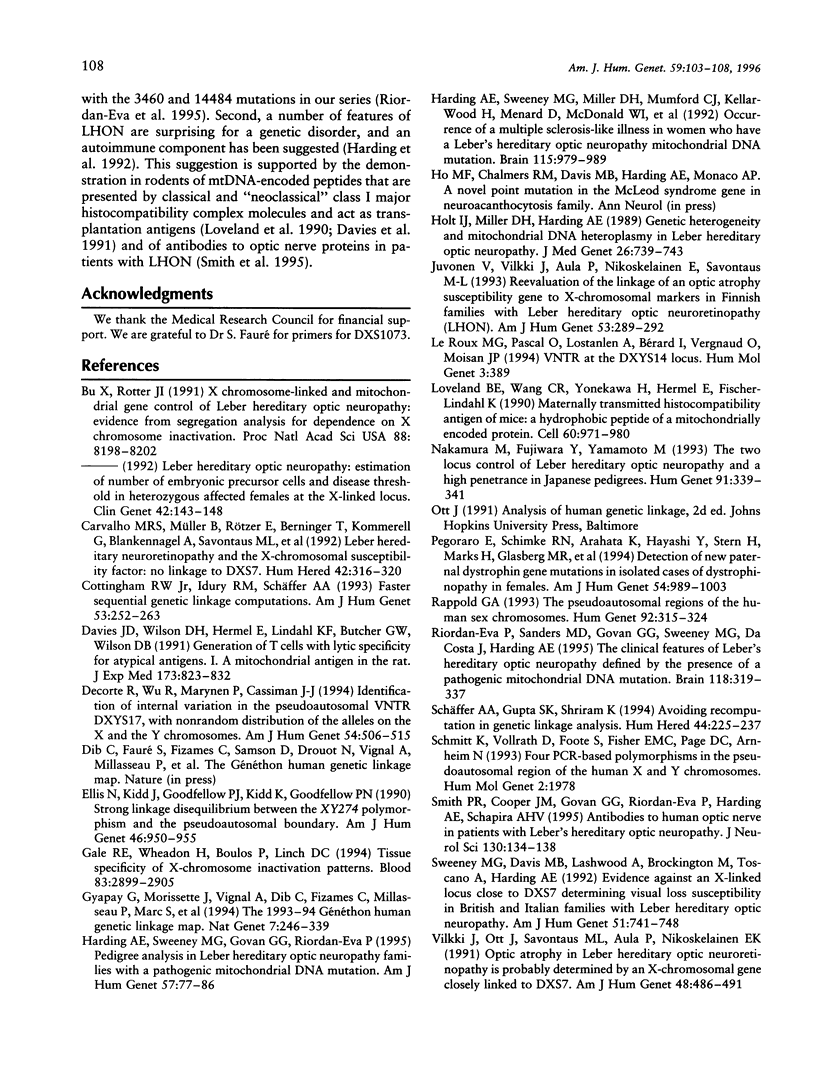
Selected References
These references are in PubMed. This may not be the complete list of references from this article.
- Bu X. D., Rotter J. I. X chromosome-linked and mitochondrial gene control of Leber hereditary optic neuropathy: evidence from segregation analysis for dependence on X chromosome inactivation. Proc Natl Acad Sci U S A. 1991 Sep 15;88(18):8198–8202. doi: 10.1073/pnas.88.18.8198. [DOI] [PMC free article] [PubMed] [Google Scholar]
- Carvalho M. R., Müller B., Rötzer E., Berninger T., Kommerell G., Blankenagel A., Savontaus M. L., Meitinger T., Lorenz B. Leber's hereditary optic neuroretinopathy and the X-chromosomal susceptibility factor: no linkage to DXs7. Hum Hered. 1992;42(5):316–320. doi: 10.1159/000154089. [DOI] [PubMed] [Google Scholar]
- Cottingham R. W., Jr, Idury R. M., Schäffer A. A. Faster sequential genetic linkage computations. Am J Hum Genet. 1993 Jul;53(1):252–263. [PMC free article] [PubMed] [Google Scholar]
- Davies J. D., Wilson D. H., Hermel E., Lindahl K. F., Butcher G. W., Wilson D. B. Generation of T cells with lytic specificity for atypical antigens. I. A mitochondrial antigen in the rat. J Exp Med. 1991 Apr 1;173(4):823–832. doi: 10.1084/jem.173.4.823. [DOI] [PMC free article] [PubMed] [Google Scholar]
- Decorte R., Wu R., Marynen P., Cassiman J. J. Identification of internal variation in the pseudoautosomal VNTR DXYS17, with nonrandom distribution of the alleles on the X and the Y chromosomes. Am J Hum Genet. 1994 Mar;54(3):506–515. [PMC free article] [PubMed] [Google Scholar]
- Ellis N., Kidd J., Goodfellow P. J., Kidd K., Goodfellow P. N. Strong linkage disequilibrium between the XY274 polymorphism and the pseudoautosomal boundary. Am J Hum Genet. 1990 May;46(5):950–955. [PMC free article] [PubMed] [Google Scholar]
- Gale R. E., Wheadon H., Boulos P., Linch D. C. Tissue specificity of X-chromosome inactivation patterns. Blood. 1994 May 15;83(10):2899–2905. [PubMed] [Google Scholar]
- Gyapay G., Morissette J., Vignal A., Dib C., Fizames C., Millasseau P., Marc S., Bernardi G., Lathrop M., Weissenbach J. The 1993-94 Généthon human genetic linkage map. Nat Genet. 1994 Jun;7(2 Spec No):246–339. doi: 10.1038/ng0694supp-246. [DOI] [PubMed] [Google Scholar]
- Harding A. E., Sweeney M. G., Govan G. G., Riordan-Eva P. Pedigree analysis in Leber hereditary optic neuropathy families with a pathogenic mtDNA mutation. Am J Hum Genet. 1995 Jul;57(1):77–86. [PMC free article] [PubMed] [Google Scholar]
- Harding A. E., Sweeney M. G., Miller D. H., Mumford C. J., Kellar-Wood H., Menard D., McDonald W. I., Compston D. A. Occurrence of a multiple sclerosis-like illness in women who have a Leber's hereditary optic neuropathy mitochondrial DNA mutation. Brain. 1992 Aug;115(Pt 4):979–989. doi: 10.1093/brain/115.4.979. [DOI] [PubMed] [Google Scholar]
- Holt I. J., Miller D. H., Harding A. E. Genetic heterogeneity and mitochondrial DNA heteroplasmy in Leber's hereditary optic neuropathy. J Med Genet. 1989 Dec;26(12):739–743. doi: 10.1136/jmg.26.12.739. [DOI] [PMC free article] [PubMed] [Google Scholar]
- Juvonen V., Vilkki J., Aula P., Nikoskelainen E., Savontaus M. L. Reevaluation of the linkage of an optic atrophy susceptibility gene to X-chromosomal markers in Finnish families with Leber hereditary optic neuroretinopathy (LHON) Am J Hum Genet. 1993 Jul;53(1):289–292. [PMC free article] [PubMed] [Google Scholar]
- Le Roux M. G., Pascal O., Lostanlen A., Bérard I., Vergnaud O., Moisan J. P. VNTR at the DXYS14 locus. Hum Mol Genet. 1994 Feb;3(2):389–389. doi: 10.1093/hmg/3.2.389-a. [DOI] [PubMed] [Google Scholar]
- Loveland B., Wang C. R., Yonekawa H., Hermel E., Lindahl K. F. Maternally transmitted histocompatibility antigen of mice: a hydrophobic peptide of a mitochondrially encoded protein. Cell. 1990 Mar 23;60(6):971–980. doi: 10.1016/0092-8674(90)90345-f. [DOI] [PubMed] [Google Scholar]
- Nakamura M., Fujiwara Y., Yamamoto M. The two locus control of Leber hereditary optic neuropathy and a high penetrance in Japanese pedigrees. Hum Genet. 1993 May;91(4):339–341. doi: 10.1007/BF00217353. [DOI] [PubMed] [Google Scholar]
- Pegoraro E., Schimke R. N., Arahata K., Hayashi Y., Stern H., Marks H., Glasberg M. R., Carroll J. E., Taber J. W., Wessel H. B. Detection of new paternal dystrophin gene mutations in isolated cases of dystrophinopathy in females. Am J Hum Genet. 1994 Jun;54(6):989–1003. [PMC free article] [PubMed] [Google Scholar]
- Rappold G. A. The pseudoautosomal regions of the human sex chromosomes. Hum Genet. 1993 Oct;92(4):315–324. doi: 10.1007/BF01247327. [DOI] [PubMed] [Google Scholar]
- Riordan-Eva P., Sanders M. D., Govan G. G., Sweeney M. G., Da Costa J., Harding A. E. The clinical features of Leber's hereditary optic neuropathy defined by the presence of a pathogenic mitochondrial DNA mutation. Brain. 1995 Apr;118(Pt 2):319–337. doi: 10.1093/brain/118.2.319. [DOI] [PubMed] [Google Scholar]
- Schmitt K., Vollrath D., Foote S., Fisher E. M., Page D. C., Arnheim N. Four PCR-based polymorphisms in the pseudoautosomal region of the human X and Y chromosomes. Hum Mol Genet. 1993 Nov;2(11):1978–1978. doi: 10.1093/hmg/2.11.1978. [DOI] [PubMed] [Google Scholar]
- Schäffer A. A., Gupta S. K., Shriram K., Cottingham R. W., Jr Avoiding recomputation in linkage analysis. Hum Hered. 1994 Jul-Aug;44(4):225–237. doi: 10.1159/000154222. [DOI] [PubMed] [Google Scholar]
- Smith P. R., Cooper J. M., Govan G. G., Riordan-Eva P., Harding A. E., Schapira A. H. Antibodies to human optic nerve in Leber's hereditary optic neuropathy. J Neurol Sci. 1995 Jun;130(2):134–138. doi: 10.1016/0022-510x(95)00021-s. [DOI] [PubMed] [Google Scholar]
- Sweeney M. G., Davis M. B., Lashwood A., Brockington M., Toscano A., Harding A. E. Evidence against an X-linked locus close to DXS7 determining visual loss susceptibility in British and Italian families with Leber hereditary optic neuropathy. Am J Hum Genet. 1992 Oct;51(4):741–748. [PMC free article] [PubMed] [Google Scholar]
- Vilkki J., Ott J., Savontaus M. L., Aula P., Nikoskelainen E. K. Optic atrophy in Leber hereditary optic neuroretinopathy is probably determined by an X-chromosomal gene closely linked to DXS7. Am J Hum Genet. 1991 Mar;48(3):486–491. [PMC free article] [PubMed] [Google Scholar]


